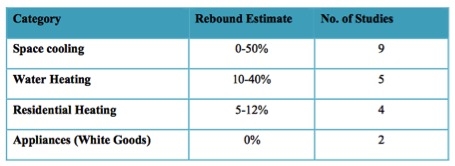
This effect is called: the rebound effect. In the most general terms, rebound effect (or take-back effect) is the extent to which the estimated energy savings enabled by the enhancement in energy efficiency are reduced by the behavioural response (i.e., higher consumption) to the increase in efficiency (1).
This phenomenon is common in a lot of sustainable products. On the one hand the increasing time of use, which can be seen in the showerhead and a low energy light bulb. On the other hand the size of products, this for example can be seen in energy saving fridges. People will buy a bigger fridge, because they know it’s a energy saving fridge. The following table shows what several studies have encountered:
We can conclude that the influence can vary in different products. The rebound that we discussed until now is the direct rebound effect. The indirect rebound effect reflects the impact of re-spending the money that consumers and businesses save from improved energy efficiency(3). From this extra money consumers can buy more (unnecessary) products. It can also include the fact that as factories and other parts of the economy get more efficient, production costs may be lower, freeing up funds to expand the factory(4).
The rebound effect doesn’t ensure that the product failed, but shows that the use is different then expected. The sustainable market is still a promising market, because it creates durable alternative products. We can conclude that the rebound effect is important to take into account in the risk analysis of (sustainable) products.
Sources:
1 and 2 Sheetal Gavankar & Roland Geyer (June 26, 2010 ). The Rebound Effect : State of the Debate and Implications for Energy Efficiency Research. Source: http://iee.ucsb.edu/files/pdf/Rebound%20Report%20for%20IEE-UCSB_0.pdf
3 and 4 Steven Nadel (august 2012). The Rebound Effect: Large or Small? source:http://aceee.org/files/pdf/white-paper/rebound-large-and-small.pdf
5. Table: Sheetal Gavankar & Roland Geyer (June 26, 2010 ). The Rebound Effect : State of the Debate and Implications for Energy Efficiency Research. Source: http://iee.ucsb.edu/files/pdf/Rebound%20Report%20for%20IEE-UCSB_0.pdf
6. Image composed by Lisa Gerards
